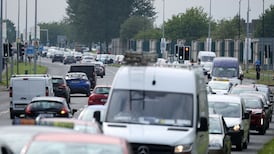A Galway researcher is studying how the body protects its DNA from our hostile environment, writes Courtenay Norbury.
'Our DNA is under constant attack," warns Dr Kevin Roche, a biochemist at NUI Galway. Exposure to ultraviolet light, reactive chemicals, toxic agents and the intrinsic instability of the DNA itself spells trouble for our bodies.
"Fortunately for us, these attacks are largely counterbalanced by promptly deployed, multifaceted surveillance and rescue mechanisms," the scientist states. However, in a small percentage of cases the damage response mechanisms are faulty and unable to take action in the damaged cell.
Dr Roche recently won an Embark postdoctoral research fellowship to investigate the body's response to DNA damage.
"Ninety-five per cent of the time damaged cells will commit suicide, which is a good thing. If the damaged cell doesn't die, it will become unstable." Genomic instability can lead to the development of cancer in multicellular organisms.
Dr Roche's research focuses on the molecules or proteins that recognise instability. "I am particularly interested in a molecule termed 53BP1 and its associated proteins," he says.
"We know that 53BP1 is one of the components that plays a role in recognising DNA damage, but we know very little about its interactions with other proteins."
In his work, Dr Roche grows human cells in the laboratory and then damages the DNA in a proportion of the cells by exposing them to ultraviolet light or chemical agents.
"We then purify 53BP1 in specific conditions so that we do not disrupt the interactions with other proteins. By comparing the purifications in untreated cells versus the damaged cells, we are able to see the proteins that are unique to cell damage," Dr Roche explains.
An understanding of the pathways that are activated following DNA damage could have important implications for cancer research. "If we look at cancer cells, we would expect that these components of DNA damage response are not working properly, Dr Roche says. "An increased knowledge of the cancerous state will definitely help us fight the disease."
Dr Roche is able to conduct this research independently but the Embark Initiative allows him to benefit from the supportive environment of a more senior laboratory. The scheme, operated by the Irish Research Council for Science, Engineering and Technology (IRCSET), is designed to encourage the most talented scientists and scholars to advance their careers here in Ireland rather than abroad. This year, the council has invested €4.6 million to fund 53 scientists covering a broad range of projects.
Another scientist to benefit from the scheme is Dr Paul Chambers, a research fellow at the Optical Fibre Sensor Research Centre at the University of Limerick. He is working with European collaborators to develop a car exhaust sensing device that will enable an automobile's control systems to measure gas emissions. "The sensor will indicate whether or not the engine is burning fuel efficiently," he says.
Dr Chambers's team is developing "optical emitters", in which a laser or LED is passed through a sample of gas. "By measuring the amount of optical power absorbed, the gas species, carbon monoxide or carbon dioxide, can be determined and the amount of gas emitted can be quantified," Dr Chambers explains.
The device itself would be quite compact and would be buried in the engine, next to the car's exhaust system. Dr Chambers predicts the sensor could be integral to all new cars "within the next 10 years".
Although Dr Chambers currently focuses his research on automobile emissions, he foresees a variety of environmental and health applications for this technology.







